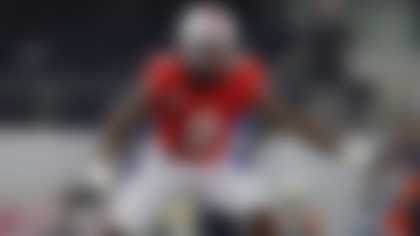Football is the ultimate team game, but all positions are not created equal.
Given the pass-happy nature of today's NFL, quarterbacks are clearly the most important players in the game, due to their responsibilities and direct impact on the outcome. What about the other players on the field? How do team builders rank and prioritize the rest of the positions on the roster?
Given some time to reflect on conversations I've had with scouts and coaches over the years, I thought I'd rank the positions in order of importance/value. Here is my hierarchy, with three notable examples at each spot for quick reference:
1) Quarterback
There's no disputing the importance of the position in 2015. The quarterback is not only the team's biggest decision maker, but his ability to make timely plays and efficiently manage the game routinely determines which team lands in the winner's circle at the end of the season.
2) Designated pass rusher 1 (RDE/ROLB)
Given the importance of the quarterback position on the outcome of games, every team must have a defensive playmaker along the front line with the potential to disrupt the timing and rhythm of the passing game. Sacks and quarterback pressures are coveted at a premium, making blind-side pass rushers hot commodities on the open market. Since most signal callers are right-handed, the game's top pass rushers typically align at RDE or ROLB to attack from the back side. J.J. Watt, listed as a notable example just below, is a bit unique, as he moves all over the D-line, but how could I construct a file about positional importance without mentioning the most dominant defensive player in the game today?
3) Left tackle
Keeping the all-important quarterback protected is obviously a top priority. Thus, the second-most crucial offensive position is left tackle, due to the presence of dangerous pass rushers on the QB's blind side. Premier LTs are capable of snuffing out dynamic rushers without assistance, and decision makers are always on the hunt for nimble pass protectors with great skill.
4) Left cornerback
The NFL's growing emphasis on the passing game makes it imperative to have a talented cover corner in the lineup to discourage throws to the prominent side of the field (for a right-handed QB). While some teams elect to have their top corner "travel" -- to match up with the opponent's top receiver -- traditionalists play the percentages and position their top cover man on the side quarterbacks target the most.
5) Wide receiver 1
The rule changes limiting downfield contact with receivers have made WR1s the top playmakers on most offenses. Teams are taking advantage of contemporary officiating by prominently featuring big-bodied and/or speedy receivers in the game plan, to help quarterbacks post ridiculous numbers while moving the offense down the field.
6) Defensive tackle
Despite the emphasis on the passing game, defensive coaches still build strategies around the initial premise of stopping the run. Interior defenders who can destroy running plays between the tackles while also delivering consistent sack production are worth their weight in gold in today's NFL.
7) Running back
Many of the top teams in the NFL still rely on a powerful ground game fueled by a dominant runner. The presence of a standout RB alleviates the pressure on the quarterback and gives the offense the balance needed to win against elite defenses.
8) Designated pass rusher 2 (LDE/LOLB)
Ideally, elite defenses have the capacity to attack the passer from both edges. While the DPR1 typically commands the bulk of attention, a dynamic edge rusher on the strong side can exploit an inferior pass protector at right tackle and speed up the quarterback's internal clock.
9) Middle linebacker
The "Mike" linebacker remains the primary communication position on defense. He takes the call from the sideline and is primarily responsible for making the adjustments along the front line. In addition, the Mike patrols the box from sideline to sideline and racks up a ton of tackles as the fast-flow player on the second level.
10) Tight end
The rules restricting excessive contact and big hits on defenseless receivers have led more teams to feature an athletic, big-bodied tight end in the passing game. These basketball-like athletes are outstanding red-zone weapons, but they primarily do their damage between the hashes on various "post-up" plays. With offensive coordinators intent on making life easier for the quarterback, the presence of a big target in the middle increases the efficiency of the passing game.
11) Free safety
Most defensive coordinators still subscribe to the theory that elite defenses are strong down the middle. Thus, teams are constantly searching for an impact "MOF" (middle of the field) playmaker to discourage throws between the numbers. Ball skills, instincts and solid tackling ability are required for this critical role in the back end.
12) Weak-side linebacker
The 4-3 defense is no longer the predominant scheme of choice in the NFL, but "Will" linebackers remain designated playmakers for teams employing the system. These active LBs are encouraged to shoot through open gaps to hit runners in the backfield, and they're incorporated into the pass rush on creative blitzes. Thus, the best players at the position are explosive, athletic and instinctive.
13) Right tackle
The notion of right tackles playing primarily as run blockers has changed with more teams relying on the passing game. Pass protectors on the right side must be able to move defenders off the ball while also displaying the agility and lateral quickness to shadow electric edge rushers. Although most teams will, at times, use a running back or tight end to help in protection, the position now requires better athletes and pass blockers.
14) Right cornerback
Offensive coordinators routinely throw away from the opponent's top cover corner, leading to more throws to the defensive right. Consequently, defensive coaches are placing better athletes and technicians at right cornerback, to suffocate the passing game.
15) Right guard
The utilization of "slide" protection requires teams to place a solid pass blocker at right guard. This scheme routinely pushes the center to the left to help the left guard, leaving the right guard to face a talented defensive tackle in a one-on-one matchup. In the run game, right guards must be able to move defensive tackles and cut off linebackers on the second level.
16) Wide receiver 2
Despite the increased importance of the WR1 and tight end in most NFL passing games, offensive coordinators still covet a legitimate threat on the back side capable of forcing the defense to defend the entire field. Although most WR2s aren't capable of carrying a passing game over the entire season, the best ones have the capacity to anchor the offense on a short-term basis. Thus, they offer tremendous value for teams built around the play of the quarterback.
17) Center
Some would argue that the center deserves a higher spot on this list, due to his important role as communicator and leader. The center controls most of the adjustments at the line, alleviating some of the pressure on the quarterback to act as the traffic cop. Although offensive coaches place a greater emphasis on instincts and football aptitude, the players at the position with superior athleticism and agility allow creative play designers to utilize crafty schemes at the point of attack.
18) Strong safety
Strong safeties are pegged as run stoppers, but defensive coordinators also expect them to act as enforcers in the middle of the field on passing plays. Big hitters not only discourage receivers from venturing between the hashes, but their presence in the middle forces quarterback to look elsewhere for high-percentage completions. Given their overall impact, strong safeties might be a tad underrated in the team-building process.
19) Strong-side linebacker
The reduced role of the running game has turned "Sam" linebackers into two-down players -- unless they exhibit special qualities on passing downs (blitz/pass-rush ability or cover skills). The premier players at the position are versatile defenders with superb agility and athleticism.
20) Left guard
Every position along the offensive line has a significant impact on the production of the offense, but many coaches will stash their most vulnerable front-line blocker at left guard. The position requires a blocker to possess the strength and power to move defenders off the ball on running plays, but coaches can mask a player's deficiencies at the point of attack by instructing the center to double-team or chip before climbing to the second level. The same tactics can be employed in pass protection, depending on the athleticism and agility of the left guard.
21) Nose tackle
Nose tackles are viewed as run stuffers, but the elite players at the position also possess the skills to collapse the pocket up the middle. Depending on the scheme (3-4 or 4-3) and skills of the player, a nose tackle typically isn't factored into the pass rush. Thus, an NT capable of delivering significant sack production brings more value to a defense.
22) Wide receiver 3
The aerial evolution of the NFL has led most teams to feature a WR3 (or TE2) instead of a fullback in the starting lineup. Although most WR3s will align in the slot, some teams will move one of their top receivers inside to exploit a favorable matchup against a nickel corner. As a result, the job description for a WR3 is team-specific, but many squads count on the sub-pass catcher to come in and make plays when the defense makes a concerted effort to snuff out the WR1.
23) Kicker
Kickers are routinely treated as afterthoughts by casual observers, but coaches certainly appreciate a scorer capable of putting points on the board from long distance. Kickers adept at knocking the ball through the uprights from 50-plus yards expand the scoring zone for the offense, providing the coordinator with more play-calling options.
24) Punter
The field-position battle doesn't show up prominently in the box score, but coaches understand the crucial role punters play in flipping the field. Securing a punter capable of combining hang time and distance is important, but some coaches prefer guys able to consistently knock the ball down inside the 20-yard line on "coffin corner" kicks.
25) Return specialist
The recent rule change on kickoffs has led to more touchbacks and dramatically reduced the role of the kick returner, but special teams coaches still covet a playmaker at the position. Returners capable of pushing the ball out past the 30-yard line not only increase the odds of scoring on offense, but they set the table for winning the field-position battle. Punt returners have more opportunities to impact the game in today's NFL; special teams mavens look for guys with the potential to average 10-plus yards on each touch.
Follow Bucky Brooks on Twitter @BuckyBrooks.












